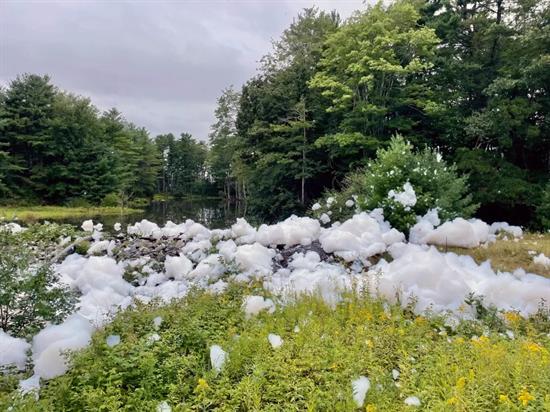Press Releases
After Largest Toxic Foam Spill in State History, Maine Delegation Presses Navy for Answers
Washington,
September 16, 2024
Members of Maine Congressional Delegation, led by Congresswoman Chellie Pingree (D-Maine), are calling on the U.S. Navy to work with State and local officials after a malfunctioning fire suppression system at Brunswick Landing, formerly known as Brunswick Naval Air Station, caused the largest toxic foam spill in state history. The toxic foam contained PFAS chemicals. Although much of Brunswick Landing is now overseen by the Midcoast Regional Redevelopment Authority (MRRA), the Navy retains ownership over certain areas, including hangar four where the spill occurred. “We have been informed that the Navy had planned to remove the fire suppression system at hangar 4 and other Brunswick facilities this month,” the Delegation said in a letter to Navy Secretary Carlos Del Toro. “We are further concerned that thousands of gallons of [aqueous film-forming foam] AFFF remain on site as part of the fire suppression systems in additional hangars at Brunswick Landing.” “Our constituents are deeply concerned about the short and long-term health and environmental impacts of this spill, as well as potential future incidents, since AFFF foam remains at the site,” they continued. “[…] We ask for your commitment to coordinating with federal, state, and local partners in providing assistance as the clean-up continues. Further, we request a briefing on the status of the Navy’s involvement in these efforts at your earliest convenience.” The full letter is available online here and copied below. Background: Per- and polyfluoroalkyl substances (PFAS) are dangerous man-made “forever chemicals” that pose serious risks to public health and the environment, appearing at our former military installations, farms, and water systems. PFAS chemicals are persistent, bioaccumulative, and toxic. These chemicals have been linked to harmful human health effects, including cancer, reproductive and developmental harms, and weakened immune systems. This is an urgent public health and environmental threat, and it’s growing at an alarming rate—in Maine, there have been more than 30,000 records of PFAS at close to 250 sites across the state, including the former Brunswick Naval Air Station, the former Loring Air Force Base in Aroostook County, and the Kennebunkport, Kennebunk, and Wells Water District. In 2019, the Maine Delegation voted to require the Department of Defense (DOD) to discontinue use of AFFF at its installations after October 1, 2024, as part of the National Defense Authorization Act for 2020. In January 2023, the DOD released new requirements for firefighting foam used to put out jet fuel fires, a pivotal step to phaseout firefighting foams with toxic PFAS. Pingree is Ranking Member of the House Interior, Environment, and Related Agencies Appropriations Subcommittee, which oversees the Environmental Protection Agency, the agency leading efforts to safeguard communities from PFAS contamination. As a member of the Congressional PFAS Task Force, Pingree has championed efforts to clean up forever chemicals and protect communities impacted by PFAS contamination. +++ Dear Secretary Del Toro: We are writing to raise our concerns to you about the recent toxic foam spill at the Former Brunswick Naval Air Station. On August 19, 2024, a malfunction in a fire suppression system in hangar four at Brunswick Landing, formerly known as Brunswick Naval Air Station, discharged 1,450 gallons of aqueous film-forming foam (AFFF) mixed with 50,000 gallons of water, filling the hangar and spilling into an oil/water separator and into retention pond “A.” This is the largest accidental AFFF spill in the state of Maine, and the sixth largest in the U.S. in the past 30 years. According to the Environmental Protection Agency (EPA), exposure to per- and polyfluoroalkyl substances, also known as PFAS, has been linked to harmful health effects in humans and animals. Results from samples taken at the Brunswick site showed that PFOS, a type of PFAS that EPA has designated as hazardous under the Comprehensive Environmental Response, Compensation, and Liability Act (CERCLA), was detected in the AFFF product sample from the storage tank at 3,230 parts per million (ppm) and in the mixed product sample (AFFF + water) at 7.52 ppm. Though much of Brunswick Landing is now overseen by the Midcoast Regional Redevelopment Authority (MRRA), the Navy retains ownership over certain areas, including hangar four. Our understanding is that the operations and maintenance of hangar four including the AFFF system is a responsibility of MRRA under the conditions of the lease with the Navy. We have been informed that the Navy had planned to remove the fire suppression system at hangar 4 and other Brunswick facilities this month. We are further concerned that thousands of gallons of AFFF remain on site as part of the fire suppression systems in additional hangars at Brunswick Landing. Our constituents are deeply concerned about the short and long-term health and environmental impacts of this spill, as well as potential future incidents, since AFFF foam remains at the site. We understand that the Department of the Navy has been communicating with MRRA, Maine Department of Environmental Protection (MEDEP) and US Environmental Protection Agency (EPA) Region 1 since the spill. We ask for your commitment to coordinating with federal, state, and local partners in providing assistance as the clean-up continues. Further, we request a briefing on the status of the Navy’s involvement in these efforts at your earliest convenience. Sincerely, ### |


